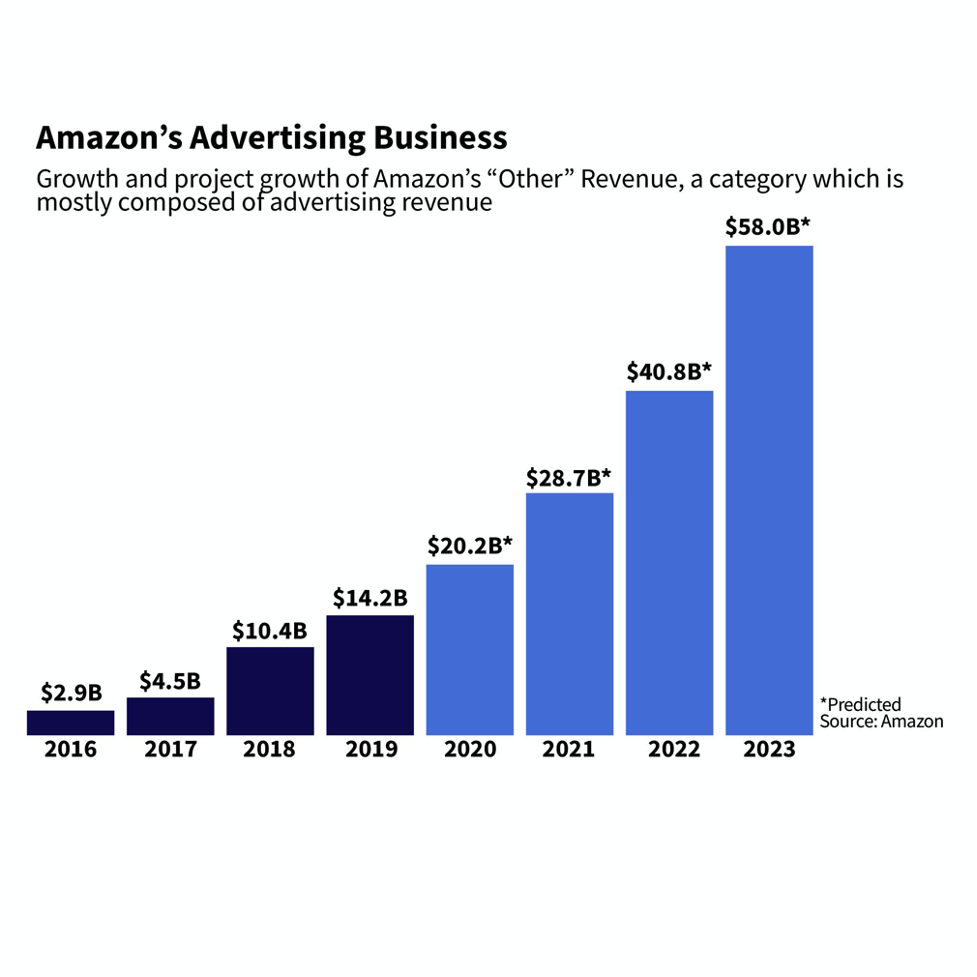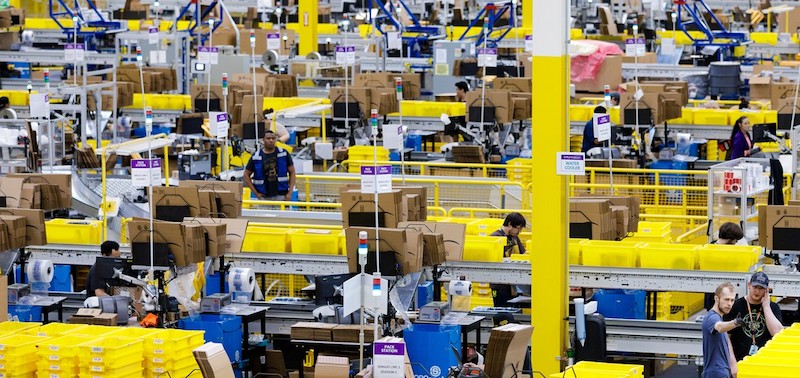Everyone knows that Amazon sells a lot of stuff. But what most people don’t know is that Amazon collects billions in advertising fees to do it. In fact, Amazon is the third-largest internet advertiser, trailing just behind Google and Facebook. In 2019 alone, Amazon racked up roughly $14 billion in advertising revenue, and made a substantial dent in Google’s dominant market share.
Previous articles in this series have discussed how Amazon uses two different AI-powered features to drive record-breaking sales. While it’s always hard to prove causation, the data suggest that Amazon’s AI-based product recommendations drive $30+ billion in sales, while its search functions generate another $10+ billion in sales. However, with multiple years of +40% annual growth, the company’s advertising revenue is quickly eclipsing all other channels.

In this article, I won’t just explain how Amazon generates billions in advertising revenue. I’ll also explain why its lucrative advertising business is entirely dependent on its AI-powered features like search and product recommendations. This will effectively tie all three Amazon-themed articles together, to prove that while Amazon offers many different features and services, the true core of its retail business is an AI-centric approach to sales.
What do Amazon Ads Look Like?
If you search for something on Amazon, you are extremely likely to see products tagged with a small “sponsored” label. This means that the vendors selling those products paid to have them appear on your screen. The good news for those retailers, however, is that they will not be charged unless you actually click on their product.
This type of pay-per-click advertising is not unique to Amazon. Facebook Google, and LinkedIn all offer similar advertising and pricing structures. But, for many vendors, Amazon is a great bet because it is a shopping platform. When consumers begin to search for a new item they intend to buy, 66% of them start on Amazon. So, if companies want consumers to buy their products on Amazon, then it is a near necessity to advertise with the e-commerce giant.
Also see: “The Technology Behind Amazon’s Search Dominance.”
Amazon also runs “sponsored brand” advertisements. This means that vendors and companies can pay to be more substantially featured when customers are searching for products. For example, if I searched “headphones” on Amazon, I might see a special banner featuring all Bose headphones. If I clicked on that banner, I may be taken to a specially designed, Bose-sponsored, landing page.
Finally, Amazon also charges vendors to run special display ads and video ads. These do not always directly appear while customers are shopping but can pop up when Amazon customers are browsing around on their Kindles or watching Amazon’s Fire TV. Clearly, it pays to own your customers’ attention.
Why Amazon Advertising Works
At this point, you might be asking why Amazon advertising is so profitable. It’s not like Amazon invented sponsored items or brands or was the first company to start monetizing viewing audiences. The real secret to Amazon’s success isn’t that they invented a new form of advertising, but that they do two things better than pretty much anyone else. First, they own their customers’ attention. And second, they own their customers’ data. Let me explain.
In 2019, Feedvisor released a truly shocking report detailing the behavior of Amazon customers. In a survey of thousands of Americans, 89% of all consumers reported that they were more likely to buy products from Amazon than any other e-commerce platform. Clearly, Amazon is the final destination for most online shoppers.
What’s even more impressive than that is how frequently Amazon is the starting point for online shoppers. The Feedvisor survey found that two-thirds of consumers start their search for new products on Amazon. This means that Amazon owns the majority of online shoppers’ attention from start to finish. Most people don’t find Amazon when they look for products. Instead, they go to Amazon to find products.
The other half of Amazon’s advertising success is their outstanding AI features. As I’ve explained in previous posts, Amazon is remarkably good at using customer data and behavior to figure out what products customers want to buy. As Amazon’s CFO recently explained, “What we’re focused on really at this point is relevancy — making sure that the ads are relevant to our customers, helpful to our customers. … We use machine learning, and it’s helping us to drive better relevancy.”
When it comes to advertising, attention and relevance are a winning combination. Vendors are willing to pay Amazon to advertise their products, because they understand that Amazon is great at grabbing customer attention, understanding customer desires and pitching the right products to the right customers at the right time.
The CMO of Goat Consulting recently called Amazon “an advertiser’s dream,” explaining that the company yielded conversion rates of 20% to 30%. Facebook advertisements, in contrast, tend to yield between 1% and 10%.
Toward an AI-Centric Business
As it turns out, being an advertiser’s dream pays very, very well. Over the last several quarters, advertising has been one of Amazon’s quickest-growing revenue streams. Most recently, Amazon’s second quarter advertising revenue grew by more than 40% to $4.22 billion. If Amazon can sustain this pace, it will haul in $20 billion in advertising revenue by the end of 2020.
While it’s easy to get excited about Amazon’s advertising business, it’s critical to remember that it is just one part of an extremely profitable puzzle. Without an AI-enhanced shopping experience that continually builds customer loyalty, attracts almost undivided attention and reveals customer preferences, Amazon would not be able to advertise at all.
As time wears on, Amazon is inching closer and closer to achieving a sort of totalizing AI-platform. The tech giant is not just owning customer attention in terms of B2C shopping but also has made moves to expand into B2B sales (Amazon Business), video (Amazon Prime TV) and music (Amazon Music). As Amazon gains more customer attention and data, it also gains more opportunities for sales and advertising.
Also see: “Amazon’s Secret to AI-Powered Product Recommendations.”
It’s always hard to tell where a virtuous cycle like this starts or stops. Amazon uses AI to interpret data and figure out what customers want. This allows it to own customer attention, sell more products, and to collect advertising payments from vendors. This creates billions in revenue, which Amazon continually rolls back into collecting more data and creating better AI features. And so, the multi-billion-dollar wheels keep on turning.
To stay competitive with Amazon, distributors will need to enact similar virtuous cycles. Fortunately, distributors already have a solid starting point. They have customer attention and they have data. Now the next step is monetizing it with AI. To learn more, check out our whitepaper.
Related Posts
-
Amazon's new fulfillment center in Republic, Missouri, near Springfield, will create hundreds of new full-time…
-
Amazon's new fulfillment center in Madison County, Mississippi, will create hundreds of new full-time jobs…
-
Amazon's new 820,000 square-foot site in the city of Pflugerville will create 1,000 new, full-time…






